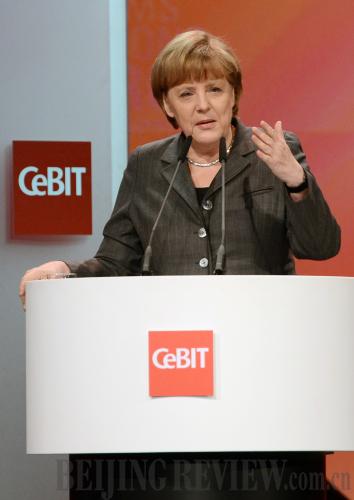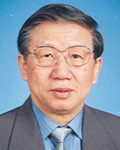|
 |
|
POPULAR LEADER: German Chancellor Angela Merkel speaks at the opening ceremony of the CeBIT technology fair in Hanover on March 4, 2013 (MA NING) |

Deep and complicated changes have been ongoing in Germany's political architecture in recent years. The biggest German political party, the Christian Democratic Union/Christian Social Union (CDU/CSU), maintains a wide influence under current Chancellor Angela Merkel's leadership, boasting an approval rating of over 40 percent. Compared with leaders of other parties, Merkel has the highest approval rating at over 50 percent.
At a time when the United States is struggling with the financial crisis and many European countries are in trouble due to sovereignty debt crises, Germany has never shifted its focus from the economy. It has managed to sustain stable economic development, becoming an outstanding performer among European economies. Germany values the healthy development of the euro zone, and considers it a solution to sovereignty debt crises. It offers financial support to crisis-ridden European countries on condition that they adopt tight fiscal policies. Germany's international status is on the rise, as some EU countries refer to it as the leader and super power of the EU.
In the local parliamentary election of Lower Saxony in January, however, the Social Democratic Party of Germany (SPD) and the Greens beat the CDU and its ally, the Free Democratic Party (FDP), albeit in a weak victory of just one seat. The CDU took 36 percent of the votes in the state election, the SPD 32.6 percent, FDP 9.9 percent, and the Greens 13.7 percent. The Left Party and the Pirate Party both failed to win 5 percent of the votes, which means they will not be included in the next state parliament. The election results foreshadow a furious fight between the two major parties of Germany, CDU/CSU and SPD, in the coming federal election in September.
Party shakeup
German media assign names to each party: black for CDU/CSU, red for SDP, green for the Greens, yellow for FDP, and red for the Left. Whether in the general election or local elections, parties sharing similar stances can form administrative coalitions through negotiations carried out before or after elections. For most of the time after World War II, CDU/CSU and SDP have formed alliances respectively with FDP and the Greens. Occasionally, the two major parties formed a large coalition government.
Theoretically, if a major party and its ally fail to get over half the votes in an election, the major party can form an administrative coalition with two other small parties. For example, there can be a coalition of SPD, FDP and the Greens with a red-yellow-green ("traffic lights") pattern. There also may be a coalition of CDU, FDP and the Greens with a black-yellow-green pattern (dubbed "Jamaica" because its colors match that country's national flag). However, these two patterns have never occurred because of the mutual repulsion between FDP and the Greens. A major party plus a small party is the only coalition pattern that has worked in Germany.
SPD and CDU/CSU possess a massive following of voters. But SPD's situation has been declining in recent years. Being on the left of the political spectrum, SPD members were mostly workers in the past. But lately SPD's member base is changing, as more white-collar employees join. SPD won the federal election in 1998 and formed a coalition with the Greens, with Gerhard Schroeder taking the position of chancellor.
At that time, SPD was aware that Europe's economy would soon face a crisis from an aging population and a rising debt threat. The party found that social welfare expenses had grown too quickly beyond the endurance of society. It proposed adopting an austere fiscal budget and cutting employee welfare, which led to party disputes. Former SPD Chairman Oskar Lafontaine accused the party of moving to the right. He resigned and established a new party called the Labor and Social Justice Party, a move that weakened SPD. Some SPD supporters turned to the Greens, and in the meantime SPD has shown no strong leaders. Due to the internal disputes, SPD didn't find a candidate for the next German chancellor for a long time. Last December, it finally chose Peer Steinbrueck as its candidate. But his approval rating has been around 30 percent, which is far below Merkel's.
|
